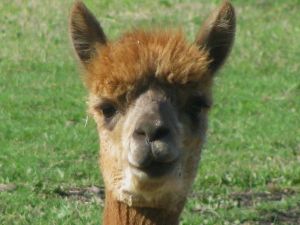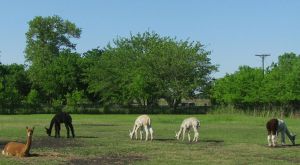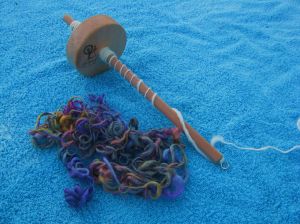The day I spent at Jacob’s Reward Farm was marvelous! Arabella and I got to help Cindy prepare for the Maryland Sheep and Wool Festival, which is happening this weekend at the Howard County Fairgrounds. Cindy wanted to take a dozen batts with her, and we were there to help.
What? What the heck’s a batt? Now I know! We made over two dozen batts in Cindy’s kitchen. We started with a pile of fleece  that had already been washed and air-dried before we got there. Sinking my hands into the pile of wool felt significant–earthy and real. Similar to the way it feels to first plant something in the garden in the spring.
that had already been washed and air-dried before we got there. Sinking my hands into the pile of wool felt significant–earthy and real. Similar to the way it feels to first plant something in the garden in the spring.
I sat at the kitchen table and “picked” the fleece–which means I separated the fibers, picked out any grass, and pulled apart any tight or snarled areas. This work prepared the fleece to go more smoothly through the drum carder.
The drum carder is what actually creates the batt–which is simply a small sheet of wool. The carder has teeth on two barrels that mesh against one another, and in that process, the fibers are further separated, smoothed out and aligned. This alignment really helps the spinner, as it allows the fibers to grab the twist added from the spinning wheel more easily.
 Arabella made all the batts by slowly feeding bits of the picked fleece through the two drums of teeth. She cranked the handle, the drums turned, she fed more fleece through, and just kept doing this until there wasn’t any more room on the drum for any more fleece.
Arabella made all the batts by slowly feeding bits of the picked fleece through the two drums of teeth. She cranked the handle, the drums turned, she fed more fleece through, and just kept doing this until there wasn’t any more room on the drum for any more fleece.
The batt will be as wide as the drum carder’s width, because you basically just peel it off the teeth at this point, and you have a batt!
But making batts is also where the magic lies…..in blending. After we had the batts completed from the fleece I was picking, Arabella went to get some white Alpaca fleece (this fleece is from Boaz).  She then rolled up a handful of Alpaca fleece inside the Jacob wool batt, rolling it like a sausage. She then fed the sausage through the drum carder, and this process blended this gorgeous,
She then rolled up a handful of Alpaca fleece inside the Jacob wool batt, rolling it like a sausage. She then fed the sausage through the drum carder, and this process blended this gorgeous,  silky, fine white Alpaca wool with the gorgeous, dense, grey Jacob wool to produce the finished batts.
silky, fine white Alpaca wool with the gorgeous, dense, grey Jacob wool to produce the finished batts.
It was a great day!











